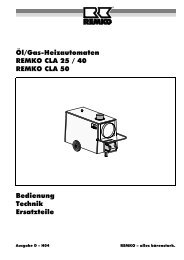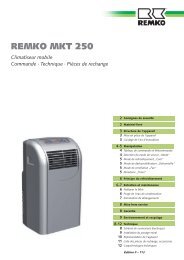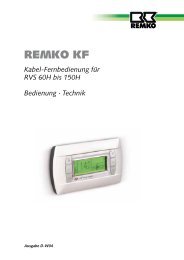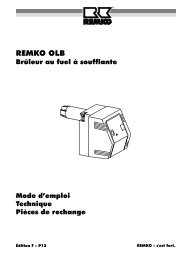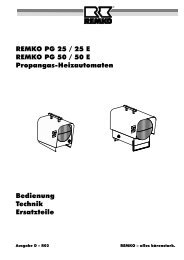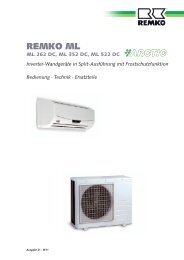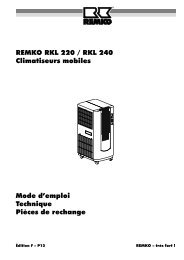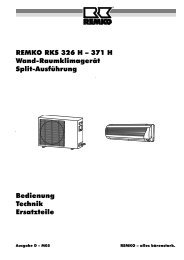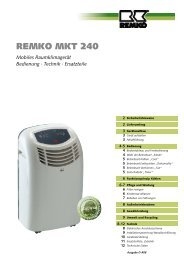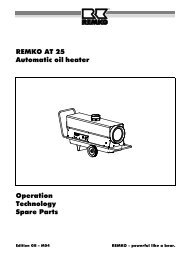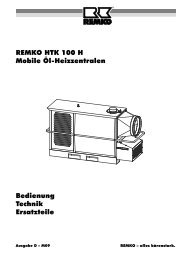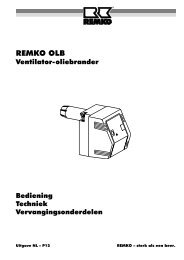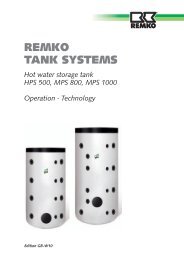REMKO ETF 100 - 150 Mobile Dehumidifier Operation Technology ...
REMKO ETF 100 - 150 Mobile Dehumidifier Operation Technology ...
REMKO ETF 100 - 150 Mobile Dehumidifier Operation Technology ...
Create successful ePaper yourself
Turn your PDF publications into a flip-book with our unique Google optimized e-Paper software.
Water Vapour Condensation<br />
The maximum possible percentage of water vapour<br />
that can be absorbed becomes higher while the air is<br />
heated, but the obtained percentage of water vapour<br />
remains unchanged, and consequently the relative air<br />
humidity is reduced.<br />
However, when the air is cooled the maximum possible<br />
percentage of water vapour that can be absorbed<br />
is continuously reduced, whereas the water vapour<br />
quantity contained in the air remains unchanged, and<br />
consequently the relative air humidity rises.<br />
When the air is further cooled off the absorption capacity<br />
regarding the maximum possible water vapour<br />
quantity is continuously reduced until it is equal to the<br />
obtained percentage of water vapour. This is the dew<br />
point temperature.<br />
If the air is cooled down below the dew point, the obtained<br />
percentage of water vapour will be higher than<br />
the maximum possible water vapour quantity.<br />
Water vapour is deposited.<br />
It condenses, is converted into water and thus is extracted<br />
from the air<br />
Steamed up window panes in winter or<br />
steamed up bottles containing cold drinks<br />
are typical examples of condensation.<br />
The higher the relative air humidity is, the<br />
higher is the dew point temperature, and<br />
consequently it is easier for the temperatures<br />
to fall below the dew point.<br />
Material Drying<br />
Building materials/buildings can absorb considerable<br />
quantities of water; e.g. bricks 90-190 l/m³, heavy concrete<br />
140-190 l/m³, calcareous sandstone 180-270 l/m³.<br />
Humid materials such as brickwork dries in the following<br />
way:<br />
◊ The contained humidity flows from the<br />
inside of the material to its surface<br />
◊ Evaporation takes place on the surface<br />
= water vapour is absorbed by the<br />
ambient air.<br />
◊ The air enriched with water vapour is continuously circulating<br />
through the <strong>REMKO</strong> air dehumidifier. It is dehumidified<br />
and leaves the apparatus in a slightly<br />
heated up state to absorb again water vapour.<br />
◊ By this the humidity contained in the material is continuously<br />
reduced; the material becomes dry.<br />
The generated condensate<br />
is collected in the<br />
apparatus and carried<br />
away.<br />
The air current is cooled off on its way through/via the<br />
evaporator until its temperature falls below the dew<br />
point. The water vapour condenses, it is collected in a<br />
condensate trap and carried away.<br />
°C<br />
30<br />
25<br />
20<br />
15<br />
% r.F.<br />
<strong>100</strong><br />
90<br />
80<br />
70<br />
60<br />
50<br />
40<br />
30<br />
20<br />
10<br />
evaporator<br />
Condensation Heat<br />
-<br />
condenser<br />
The energy transferred from the condenser to the air<br />
consists of:<br />
◊ The heat that was previously extracted in the evaporator.<br />
◊ The electric driving energy.<br />
◊ The condensation heat released by liquefying water<br />
vapour.<br />
When the liquid condition is converted into a gaseous<br />
condition energy must flow back. This energy is called<br />
evaporation heat. It does not cause the temperature to<br />
raise but is used for the conversion from the liquid to<br />
the gaseous state. On the other hand energy is released<br />
when gas is liquefied, and this energy is called<br />
condensation heat.<br />
The energy rate of evaporation and condensation heat<br />
is identical.<br />
For water this is 2250 kJ / kg ( 4,18 kJ = 1kcal )<br />
This shows that a relatively high energy rate is released<br />
through water vapour condensation.<br />
If the humidity to be condensed is not generated by<br />
evaporation within the room, but fed from the outside,<br />
e.g. by aeration, the condensation heat released<br />
thereby contributes to room heating.<br />
When materials or rooms are to be dried the heat energy<br />
flows in a circulation, i.e. it is consumed during<br />
evaporation and released during condensation.<br />
A larger amount of heat energy is generated when fed<br />
air is dehumidified, and this heat energy is expressed in<br />
the form of a rise in temperature.<br />
Generally the time needed for drying does not depend<br />
on the apparatus capacity, but it is determined by the<br />
speed at which the material or the parts of the building<br />
emit the humidity contained in them.<br />
+<br />
+<br />
air-temperature<br />
air-direction<br />
humidity<br />
course<br />
5



